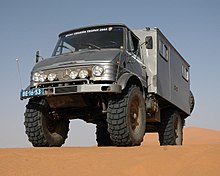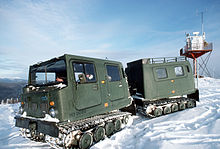Mufflers Rock!
Off-Road Mufflers
From Wikipedia, the free encyclopedia
An off-road vehicle is considered to be any type of vehicle which is capable of driving on and off paved or gravel surface.[1] It is generally characterized by having large tires with deep, open treads and a flexible suspension, or even caterpillar tracks.[citation needed] Other vehicles that do not travel public streets or highways are generally termed off-highway vehicles, which would include tractors, forklifts, cranes, backhoes, bulldozers and Golf carts.[citation needed] Off-road vehicles have an enthusiastic following because of their many uses and versatility. Several types of motorsports involve racing off-road vehicles. The three largest "4 wheel vehicle" off-road types of competitions are Rally, Desert Racing, andRockcrawling.[citation needed] The three largest types of All Terrain Vehicle (ATV) / Motorcyclecompetitions are Motocross, Enduro, and also Desert Racing like Dakar Rallye and Baja 1000.[citation needed] The most common use of these vehicles is for sight seeing in areas distant from pavement. The use of higher clearance and higher traction vehicles enables access on trails and forest roads that have rough and low traction surfaces. HistoryOne of the first modified off-road vehicles was the Kégresse track, a conversion undertaken first by Adolphe Kégresse, who designed the original while working for Tsar Nicholas II of Russia between 1906 and 1916.[2] The system uses an unusual caterpillar track which uses a flexible belt rather than interlocking metal segments. It can be fitted to a conventional car or truck to turn it into a half-track, suitable for use over rough or soft ground. Conventional front wheels and steering are used. After the Russian Revolution of 1917 Kégresse returned to his native France where the system was used on Citroën cars between 1921 and 1937 for off-road and military vehicles. The Citroën company sponsored several overland expeditions with their vehicles crossing North Africa and Central Asia. After World War II a huge surplus of light off-road vehicles like the Jeep and heavier lorries were available on the market.[citation needed] The Jeeps in particular were popular with buyers who used them as utility vehicles. This was also the start of off-roading as a hobby. The wartime Jeeps soon wore out, though, and the Jeep company started to produce civilian derivatives, closely followed by similar vehicles from British Land Rover and Japanese Toyota, Datsun/Nissan and Mitsubishi. These were all alike; small, compact four wheel drives with at most a small hardtop to protect the occupants from the elements.[citation needed] From the 1960s more comfortable vehicles were produced.[citation needed] First they were popular for many years with rural buyers due to their off-road and load-lugging capabilities.[citation needed] The U.S. Jeep Wagoneer and the Ford Bronco, the British Range Rover and thestation wagon-bodied Japanese Toyota Land Cruiser and Nissan Patrol were essentially a station wagon body on a light truck frame withfour wheel drive drivetrain. Later during the nineties manufacturers started to add even more luxuries to bring those off-road vehicles on par with regular cars. This eventually evolved into what we call the SUV today, and the newer Crossover vehicle where utility and off-road capability was sacrificed for better on-road handling and luxury. TechnicalTo be able to drive off the pavement, off-road vehicles need several characteristics: They need to have a low ground pressure, so not to sink in soft ground, they need ground clearance to not get hung up on obstacles and they need to keep their wheels or tracks on the ground so as to not lose traction.[citation needed] Wheeled vehicles accomplish this by having a suitable balance of large or additional tires and tall and flexible suspension. Tracked vehicles accomplish this by having wide tracks and a flexible suspension on the road wheels.[citation needed] The choice of wheels versus tracks are one of cost and suitability. A tracked drivetrain is more expensive and costly in terms of maintenance. Wheeled drivetrains are cheaper and give a higher top speed. For pure off-road capabilities the tracked drivetrain has the edge.[citation needed] Most off-road vehicles are fitted with especially low gearing.[citation needed] This allows the operator to make the most of the engine'savailable power, while moving through challenging terrain slowly. A combustion engine coupled to a normal gearbox often has a too high output speed to be usable. The vehicle often has one of two things; either a very low ("granny") first gear (like the all wheel driveVolkswagen Transporter versions) or an additional gearbox in-line with the first, called a reduction drive. Some vehicles, like the Bv206 in the picture on the right, also has a torque converter to further reduce the gearing.[3] Many wheeled off road vehicles have all wheel drive, to keep traction on slippery surfaces, although in vehicles designed for use both on and off road, this may be switchable so that the vehicle has fewer driven wheels when on the road. Criticism of off-road vehiclesSafety
Main article: Criticism of sport utility vehicles
SUVs are built with higher ground clearance for off-road use and have a higher center of gravity,[4] therefore increasing the risk of rollover. Research has shown that whenever an SUV turns, the vehicle's mass resists the turn and carries the weight forward allowing the traction from the tires to create a lateral centripetal force as the vehicle continues through the turn. The conflict between the top weight of the SUV's desire to go straight while the friction of the tires on the road cause the bottom of the vehicle to move away and out from under the vehicle during a turn.[5] Pickups and SUVs are more likely to be in rollover accident than passenger cars. According to a study conducted in the United States, pickups have twice the fatality rate of cars and SUVs have nearly triple the fatality rate in rollover accidents.[6] Of vehicles in the US, light trucks (includes SUVs) represent 36 percent of all registered vehicles. They are involved in about half of the fatal two-vehicle crashes with passenger cars, 80 percent of these fatalities are to occupants of the passenger cars.[6] EnvironmentIn the United States, the number of ORV users since 1972 has climbed sevenfold—from five million to 36 million in 2000.[7] Government policies that protect wilderness but also allow recreational ORV use have been the subject of some debate within the United States and other countries.[8] All trail and off-trail activities impact natural vegetation and wildlife, which can lead to erosion and invasive species, habitat loss, and ultimately species loss,[9][10] which decreases an ecosystem's ability to maintain homeostasis. [11] ORVs cause greater stress to the environment than foot traffic alone, and ORV operators who attempt to test their vehicles against natural obstacles can do significantly more damage then those who follow legal trails.[12][13] Illegal use of off-road vehicles (ORV) has been identified as a serious land management problem ranked with dumping garbage and other forms of vandalism.[14] Many user organizations, such as Tread Lightly!and the Sierra Club, publish and encourage appropriate trail ethics.[15] ORVs have also been criticized for producing more pollution in areas that might normally have none. In addition to noise pollution that can cause hearing impairment and stress in wildlife,[16] according to the U.S. Forest Service, old-style two-stroke engines (no longer a component of new off-road vehicles, although some are still in use) "emit about 20 to 33 percent of the consumed fuel through the exhaust" and "discharge from two-stroke snowmobile engines can lead to indirect pollutant deposition into the top layer of snow and subsequently into the associated surface and ground water."[17][18] In 2002, the United States Environmental Protection Agency adopted emissions standards for all-terrain vehicles that "when fully implemented in 2012... are expected to prevent the release of more than two million tons of air pollution each year -- the equivalent of removing the pollution from more than 32 million cars every year."[19][20]
Common off-road vehiclesCommon commercial off-road vehicles include four wheel drive pickup trucks like the Ford F-Series,GMC Sierra, Toyota Hilux, Dodge Ram and similar. Also common are light trucks with station wagon-like bodies, which have been very popular since the 1980s. These include Chevrolet Blazer, Dodge Ramcharger, Ford Bronco, Jeep Cherokee, International Scout,Isuzu Trooper, Isuzu Rodeo, Isuzu Amigo, Land Rover Defender, Discovery, Suzuki Grand Vitara, Range Rover, Nissan Patrol, Nissan Xterra, Lada Niva, Land Cruiser and 4Runner. The Suzuki Samurai is also a great off road vehicle that can be built much cheaper than many others. A number of those models have now become luxury SUV's with much reduced off-road capability. A number of military vehicles have also seen civilian use, including the Jeep CJ and AM GeneralHummer. Some, like the early Land Rovers, were adapted to military use from civilian specifications. Specialised commonly available off-road vehicles include ATVs, or All Terrain Vehicles, dirt bikes, dune buggies, rock crawlers and sandrails.
Commercial, military and less common off-road vehiclesEuropean militaries and utilities have used Land Rover Defenders, Haflingers, Pinzgauers and Mercedes-Benz Unimogs for all-terrain transportation. Less common is the Portuguese UMM Alter. The military market for off-road vehicles used to be large, but since the fall of the Iron Curtain in the 1990s it has to some extent dried up. The U.S. Jeep, developed during World War II, coined the word many people use for any type of light off-road vehicle. In the U.S., the Jeep's successor from the 1980s on was the AM General HMMWV. The Eastern Bloc used the GAZ-69 and UAZ-469 in similar roles.
References
Text taken as-is from Wikipedia and conforms to the Creative Commons Attribution-ShareAlike License | ||||||||||||
|












